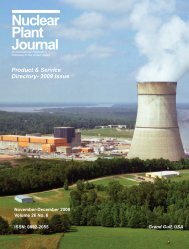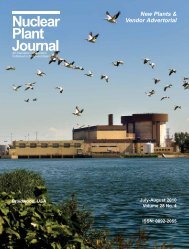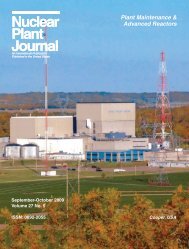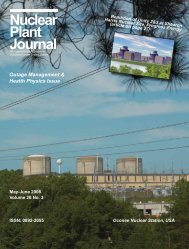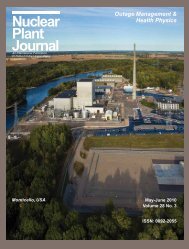Nuclear Plant Journal - Digital Versions
Nuclear Plant Journal - Digital Versions
Nuclear Plant Journal - Digital Versions
You also want an ePaper? Increase the reach of your titles
YUMPU automatically turns print PDFs into web optimized ePapers that Google loves.
A Market...<br />
Continued from page 34<br />
ACR-1000 to ensure minimum damage<br />
of the fuel during normal operation, and<br />
during accident scenarios<br />
Reference fuel for the ACR-1000<br />
is the 43-element CANFLEX-ACR<br />
(CANDU FLEXible) bundle, which<br />
incorporates 42 elements with 11.5 mm<br />
OD, 2.4% enriched LEU and one 20-mmdiameter<br />
central element with burnable<br />
neutron absorbers (BNA). Sheath material<br />
is Zircaloy-4.<br />
ACR-1000 fuel acceptance criteria<br />
for normal operation were used to<br />
systematically evaluate any potential<br />
damage mechanisms that could affect<br />
fuel robustness. This ensures that fuel<br />
cannot be damaged in fulfilling design<br />
requirements for normal operation.<br />
Design changes, listed below, help to<br />
minimize fuel damage during normal<br />
operation and accidents:<br />
• More highly subdivided 43-element<br />
CANFLEX-ACR fuel bundle,<br />
lowering fuel element ratings and<br />
reducing the power-related damage<br />
mechanisms<br />
• Fuel pellet geometry optimized to<br />
minimize sheath strains and fission<br />
gas pressure<br />
• CANLUB interlayer thickness<br />
increased to improve resistance to<br />
damage due to power ramp failures<br />
• Fuel sheath thickness defined to<br />
maintain its intrinsic collapsibility<br />
• Fuel bundle endplate geometry<br />
modified to improve irradiated fuel<br />
bundle strength during refuelling<br />
operations<br />
• Use of CANFLEX-ACR fuel<br />
bundle with AECL’s patented flowenhancing<br />
sheath appendages,<br />
providing increased margin to dryout<br />
in postulated accident conditions<br />
• Central fuel element containing<br />
BNAs to control the coolant void<br />
reactivity, thus minimizing potential<br />
for fuel damage in the case of a<br />
postulated large-break loss-ofcoolant<br />
accident (LOCA)<br />
5. How does ACR-1000 minimize<br />
damage to the fuel in case of a loss-ofcoolant<br />
accident<br />
The ACR-1000 design has<br />
incorporated some new features to<br />
minimize fuel damage that might occur<br />
during a postulated large-break Loss-of-<br />
Coolant Accident:<br />
• Reduced core lattice pitch (distance<br />
between the fuel channels), reducing<br />
the coolant void reactivity (CVR)<br />
during a postulated large-break<br />
LOCA<br />
• Increased calandria-tube diameter,<br />
resulting in reduced moderatorto-fuel<br />
ratio, which reduces the<br />
moderator volume and, hence,<br />
reduces the CVR<br />
• Enhanced fuel design, with the centre<br />
element containing zirconia with<br />
BNAs, further reducing the CVR<br />
All of the above features combine<br />
to give a small negative CVR value for<br />
nominal end-of-life conditions, such that<br />
the power transient during a large-break<br />
LOCA is benign.<br />
Changes to the fuel design make the<br />
fuel less susceptible to failure during a<br />
LOCA. As above (Question 4), the more<br />
subdivided CANFLEX-ACR fuel bundle<br />
lowers fuel element ratings and reduces<br />
the power-related damage mechanisms<br />
while fuel pellet geometry minimizes<br />
sheath strains and fission-gas pressure,<br />
ACR-1000 Four Unit Layout<br />
reducing the likelihood of fuel failures<br />
during power transients.<br />
Finally, the ACR-1000 design has<br />
retained the two independent fast-acting<br />
reactor shutdown systems, which are the<br />
well-established means of limiting the<br />
reactivity transient during a postulated<br />
large-break LOCA in traditional CANDU<br />
reactors. As a result of all of these<br />
enhancements, calculations show that<br />
during a postulated large-break LOCA,<br />
there will be no fuel failures in the ACR-<br />
1000 reactor design.<br />
6. What innovative fuel cycles have<br />
been used in ACR-1000 to maximize fuel<br />
effi ciency and to minimize concerns of<br />
proliferation<br />
The reference fuel for the ACR-<br />
1000 has a uniform 2.4% enrichment.<br />
The ACR-1000 uses the advanced<br />
CANFLEX ® fuel bundle, developed<br />
as the optimal carrier for CANDU<br />
advanced fuel cycles. Development is<br />
underway to increase enrichment and<br />
burnup, to further improve economics.<br />
In addition, Recovered Uranium (RU)<br />
from conventional reprocessing can be<br />
burned efficiently in the ACR-1000, with<br />
the addition of fissile LEU or plutonium<br />
(Pu). The reactor can operate with a<br />
full core of 2.4% LEU, or with RU plus<br />
fissile to 2.4% Heavy Element (HE). The<br />
on-power refuelling capability permits<br />
switching back and forth between the two<br />
fuel types, without any hardware changes<br />
to the safety/control systems.<br />
Additionally, spent ACR-1000 fuel<br />
with a residual fissile content of about<br />
1%, opens the possibility of its re-use<br />
in existing CANDU reactors. The ACR-<br />
1000 is also amenable to thorium fuel<br />
cycles. The simplest case, feasible in the<br />
short term, is the Once-Through Cycle<br />
(OTT). This is easy to implement, with<br />
no reprocessing required, to achieve a<br />
burnup of about 21,000 MWd/TeHE.<br />
This cycle also creates a “reservoir” of<br />
Uranium-233 (233U) for future use. In<br />
the longer term, a closed-cycle option<br />
offers burnups to 40,000 MWd/TeHE.<br />
Spent fuel is reprocessed to recycle 233U,<br />
and burnup can be tailored by adding Pu<br />
to fresh bundles.<br />
Proliferation-resistance results from<br />
a combination of technical design features,<br />
operational modalities, institutional<br />
arrangements and safeguards measures.<br />
In CANDU technology, these features are<br />
strongly linked and self-enforced, with<br />
the result that their combination is greater<br />
than the sum of the parts. CANDU technology<br />
has always incorporated intrinsic<br />
proliferation-resistance features—derived<br />
from the fundamental physics of naturaluranium<br />
or LEU-fuelled reactors.<br />
While these inherent barriers<br />
minimize the attractiveness of CANDU<br />
technology as a target for proliferation,<br />
external measures provide verification<br />
(Continued on page 38)<br />
36 http://subscribe.npjonline.com http://www.NPJOnline.com <strong>Nuclear</strong> <strong>Plant</strong> <strong>Journal</strong>, September-October 2008



